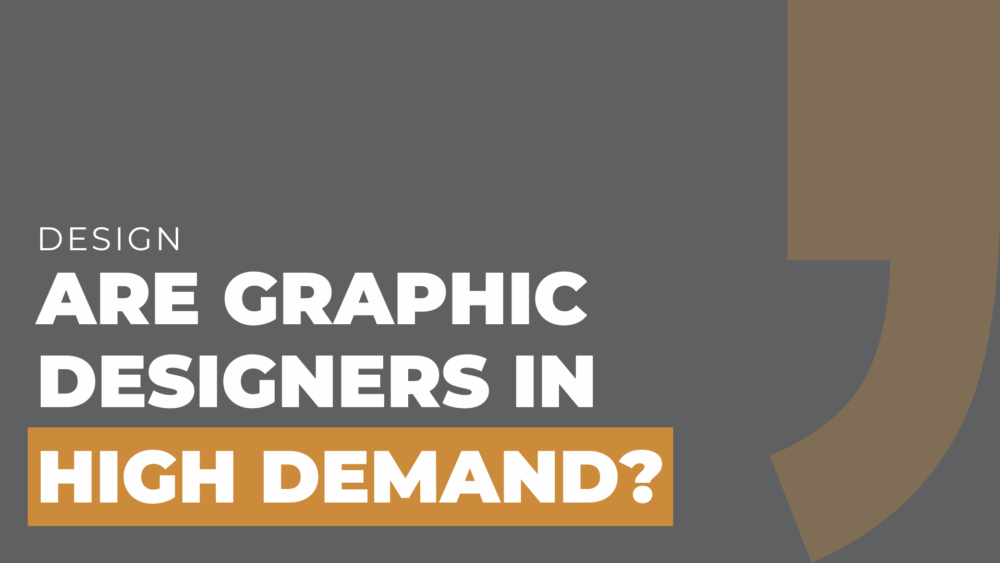In an increasingly visual and digital world, the role of graphic designers is more pivotal than ever before.
They are the silent architects behind stunning advertisements, engaging websites, and eye-catching logos that speak volumes about a brand’s identity.
But the question remains: Are graphic designers really in high demand? Is embarking on a career in graphic design truly a good idea?
Fact: In today’s digital age, where visuals play a significant role in communication and branding, the need for skilled graphic designers has skyrocketed.
The work graphic designers do is valuable to a lot of companies, because they recognize the importance of visuals in their overall branding and marketing strategies.
In fact, according to the Bureau of Labor Statistics, employment projections for graphic designers say that it is expected to grow by 4% from 2019-2029, faster than the average for all occupations.
Moreover, with the rise of digital platforms, companies need graphic designers to create compelling visuals that are responsive and user-friendly with tablets, phones, and other devices.
The demand for designers does vary depending on the amount of graphic designers who already work in your location.
Even this is changing because of technology.
Let’s learn more about the most in-demand design jobs.
In this post, we’ll delve deep into these questions, uncovering facts, insights, and strategies that could potentially shape your career decisions.
Here’s exactly what we’ll cover:
- Which Jobs are the Most In-Demand Jobs for a Graphic Designer?
- The Job Market: What are the Most In-Demand Skills for Graphic Designers?
- Graphic Designers of the Future: What’s Going to be in High Demand 10 Years From Now?
- What About increased AI? Is Graphic Design going Away?
- Setting Yourself Up for Success
Which Jobs are the Most In-Demand Jobs for a Graphic Designer?
Now that we have a grasp of the different designer roles, let’s explore which positions are currently in high demand.
While they are not all your typical “graphic designer jobs,” they are closely related and the skills you have as a designer are applicable in a lot of ways.
UI/UX Designers
Jobs in UI/ UX are constantly growing in importance, as businesses increasingly recognize the impact of an intuitive and engaging user interface on customer satisfaction and retention.
While UI/ UX is a discipline that extends slightly beyond the traditional boundaries of graphic design, it opens up myriad opportunities for designers who are willing to broaden their skill set.
Graphic designers already possess a foundational understanding of aesthetics, layout, and visual communication – skills that are highly transferable and valuable within the realm of UI/ UX.
Therefore, by embracing this evolving landscape and demonstrating flexibility, graphic designers can seize upon a wealth of creative and rewarding opportunities if you pursue jobs in UI/ UX.
Brand Identity Designers
Brand Identity Designers have jobs where they focus on the visual elements that shape a company’s brand.
This involves designing logos, color palettes, typography, and other visual materials that communicate the company’s identity to the world.
As a form of graphic design, this role requires a keen understanding of visual communication, aesthetics, and design principles.
Brand identity design is more than just creating attractive visuals; it involves deep understanding of a company’s mission, values, and audience.
Designers must be able to interpret and convey these aspects through visual elements, creating a coherent and appealing brand identity that resonates with the target audience.
For graphic designers willing to grow, change, and learn new job skills, brand identity design presents a large amount of work opportunities.
With an expanding visual landscape and the continuous evolution of branding strategies, graphic designers have the opportunity to apply their skills in innovative ways.
By embracing the challenge of brand identity design, graphic designers can thrive in a dynamic field, using their expertise to shape and define the visual voice of brands across industries.

Motion Graphics Designers
Motion graphics design is an innovative job field that brings graphic elements to life through animation.
It incorporates the principles of graphic design alongside cinematic techniques to create dynamic, engaging visuals that tell a story or convey a message.
This field is particularly relevant in today’s digital age, where attention spans are getting shorter and the need to communicate effectively and quickly is of utmost importance.
The demand for motion graphics designers is rapidly growing as businesses strive to differentiate themselves in a saturated market.
Motion graphics provide a unique way of relaying complex messages in a digestible, entertaining manner.
Moreover, the prominence of video content on social media platforms and digital advertising channels has significantly amplified the demand for this skill.
As a result, graphic designers with proficiency in motion graphics design are highly sought after, making this an exciting and promising field for them to explore and specialize in.
Web Designers
Web design represents another crucial arena where the skills of graphic designers are highly sought after.
As the digital face of businesses, websites must be both aesthetically pleasing and functional, necessitating the expertise of graphic designers who understand how to balance these elements.
Designers are tasked with creating visually striking layouts that catch the eye, while also ensuring that the site is easy to navigate and provides a seamless user experience.
The emergence of eCommerce and the shift towards digital marketing strategies have further intensified the demand for web designers.
Businesses are increasingly relying on their online presence to attract, engage, and retain customers.
This trend underscores the importance of having a well-designed website, making the role of a web designer more important than ever.
Hence, graphic designers who can adapt and tap into web design are well-positioned to meet the rising demand and seize exciting opportunities in this dynamic career field.
While these are the most in-demand design jobs currently, it’s important to note that the industry is ever-evolving.
New technologies and design trends can lead to shifts in demand, creating opportunities for designers with specialized skills.
Product Design’s Partner: Designer of the Visual Identity
A graphic designer’s role goes beyond simply creating visually appealing designs.
While they may not physically manufacture the product, their work plays an important role in elevating the product and brand.
Graphic designers possess the unique skill of translating concepts and ideas into captivating visuals that effectively communicate what a product or brand is all about.
The expertise of a graphic designer lies in their ability to create cohesive and visually striking designs that resonate with the target audience.
Through the strategic use of color, typography, layout, and imagery, they enhance the overall aesthetic appeal and establish a strong visual identity for the product or brand.
Their designs have the power to evoke emotions, convey messages, and capture the attention of consumers.
In a competitive marketplace where first impressions matter, a talented graphic designer can help a product and brand stand out from the crowd.
By understanding the brand’s values, target market, and competition, they can create designs that align with the brand’s vision and effectively communicate its unique selling points.
In this way, the work of a graphic designer not only supports the product but also serves as a powerful tool in helping the product and brand shine in the eyes of consumers.
Companies and businesses know that their reputation matters.
That’s why graphic design is still a great career to work in.

The Job Market: What are the Most In-Demand Skills for Graphic Designers?
To excel in your graphic design career, it’s vital to possess a diverse skill set that aligns with current market demands.
Here are some of the most sought-after graphic design skills:
- Proficiency in Adobe Creative Suite: The Adobe Creative Suite, including Photoshop, Illustrator, and InDesign, is the industry standard for graphic design. Mastering these tools will make you a valuable asset in the field.
- UI/UX Design: As mentioned earlier, UI/UX design is in high demand. Understanding user-centric design principles and being able to create intuitive interfaces will open doors to exciting career opportunities.
- Responsive Web Design: With the increasing use of mobile devices, being able to design websites that adapt seamlessly to different screen sizes is crucial. Responsive web design skills are highly valued in the industry.
- Typography: The art of typography can elevate a design from good to exceptional. Having a keen eye for fonts, hierarchy, and readability is a skill that sets graphic designers apart.
Graphic Designers of the Future: What’s Going to be in High Demand 10 Years From Now?
Predicting the future can be challenging, especially in the fast-paced world of design. However, some trends and technologies show promise for the future.
Here are a few areas that may be in high demand ten years from now:
- Virtual Reality (VR) – A subset of 3D design, virtual reality is an emerging technology with vast potential applications for graphic designers.
- Machine Learning Designers – As AI technologies mature, the need for machine learning designers who can work in tandem with algorithms and data sets will become even more vital.
- Motion Capture Designers – As motion capture technologies evolve, companies will need professionals who can design and implement realistic character animations and movements.
- Voice User Interface Designers (VUI) – The voice user interface (VUI) design field is growing in popularity with the advent of virtual assistants like Alexa and Siri.
Overall, the design industry is constantly changing and evolving.
As technology advances, the demand for graphic designers will grow even further.
Those with the right skills and passion for creating compelling visuals will be in high demand – now and in the future!

What About increased AI? Is Graphic Design going Away?
Artificial Intelligence (AI) is poised to revolutionize many sectors, including graphic design.
AI can streamline design processes, automate repetitive tasks, and provide data-driven insights to enhance creativity.
It can generate logos, choose color schemes, and even build website layouts in mere minutes.
However, despite its smart capabilities, AI lacks the human touch – the ability to empathize, understand subtleties, and create designs that emotionally resonate with people.
Marketing is about storytelling, creating connections, and evoking emotions, tasks that necessitate a human understanding.
Consequently, while AI will undoubtedly transform the field of graphic design, it is unlikely to eliminate the need for human designers.
The future of graphic design will likely be a blend of human creativity and AI-powered efficiency.
Setting Yourself Up for Success
Just because there is a high demand for something doesn’t mean that you’ll automatically get the job or the land the project without fighting for it.
You sill have to work hard and do your part.
Here are a few tips to help you set yourself up for success for a career in graphic design:
1.Leverage Your Personality
When it comes to distinguishing yourself as a graphic designer and setting yourself up for success, it’s essential to consider your personality type and play to your strengths.
Whether you’re an extrovert or introvert, embrace your unique qualities and find ways to showcase them in your work.
2.Be a Leader
Additionally, honing your leadership skills can make a significant difference in your career trajectory.
Being able to effectively communicate and collaborate with clients, team members, and stakeholders will not only enhance your design process but also set you apart as a go-to designer.
Lots of people are good at design, but being good at communication and business can be the thing that set you apart from other designers.
3.Portolio Work
Another way to prepare for success is to create a strong design portfolio.
Your portfolio acts as a visual representation of your skills, creativity, and expertise.
This can be online but it can help to have a physical version as well that clients can put their hands on.
This should be a diverse collection of projects that demonstrates your versatility and mastery of different design techniques.
4.Value Your Education
Alongside your portfolio, consider the educational path you choose.
While a degree in graphic design can be beneficial, real-world job experience and practical work are equally important.
Balancing both formal education programs and hands-on experience will provide you with a well-rounded skill set and strengthen your understanding of design principles and concepts.
5.Speak Your Own Language
Lastly, develop a distinct design language that sets you apart from others in the industry.
What is a design language?
A design language, also referred to as a visual language, pertains to the unique set of design elements and aesthetic principles that a designer or a brand consistently applies across their work.
It acts as a visual signature, establishing a distinctive style that can be immediately recognized in their designs.
A design language generally comprises color schemes, typography, layouts, iconography, and other graphical elements.
These components, when used consistently, create a cohesive and harmonious visual experience.
Moreover, a well-defined design language is instrumental in conveying a brand’s personality and values, thereby fostering a strong connection with the target audience.

This involves finding your unique style, experimenting with different aesthetics, and staying updated on current design trends.
Cultivating a recognizable and consistent design language will help you stand out and attract clients who resonate with your work.
Remember, setting yourself up for success as a graphic designer is a continuous journey of self-discovery, learning, and growth.
Going or Staying
So, let’s wrap things up and talk about why graphic designers are so important in marketing.
Despite all the fancy technology and automation out there, nothing beats the human touch when it comes to creating visuals that really connect with people.
Marketing is all about understanding and engaging with people, and that’s where graphic designers shine.
They ability to take complex ideas and turn them into designs that make you feel something is extremely valuable.
Whether it’s telling a story or grabbing your attention, they know how to create designs that resonate with audiences.
Is graphic design an important job?
Yes, graphic design is a big deal and a great career.
Graphic designers are pretty awesome and their job in marketing is definitely here to stay.


Comments are closed.